
Consumer Insights
Uncover trends and behaviors shaping consumer choices today
Procurement Insights
Optimize your sourcing strategy with key market data
Industry Stats
Stay ahead with the latest trends and market analysis.
The Philippines dairy market size attained a value of USD 1507.76 Million in 2025. The market is estimated to grow at a CAGR of 4.30% during 2026-2035 to reach a value of USD 2297.08 Million by 2035. The market is driven by rising consumer demand for dairy products, an expanding food service sector, and rising governmental support to expand dairy production.
Base Year
Historical Period
Forecast Period
Dairy products, such as cheese are a crucial ingredient in fast food products, such as burgers and pizzas. The fast-food sector in the Philippines is characterised by both local and international franchises. Prominent fast-food chains in the Philippines include Jollibee, McDonald’s, and Burger King. According to 2024 data, the Philippines is home to 49,629 restaurants, an 4.43% increase from 2023.
In 2023, the top milk-producing areas in the Philippines were on the island of Luzon, including Laguna, Bulacan, and Batangas. Further, Davao and Bukidnon in southern Mindanao were also major producers.
The National Dairy Authority (NDA) is prioritising the expansion of its cattle herds to support its farm operations. In 2023, Philippines total number of dairy animals increased to 31,878 from 26,002 in 2021.
Compound Annual Growth Rate
4.3%
Value in USD Million
2026-2035
*this image is indicative*
| Philippines Dairy Market Report Summary | Description | Value |
| Base Year | USD Million | 2025 |
| Historical Period | USD Million | 2019-2025 |
| Forecast Period | USD Million | 2026-2035 |
| Market Size 2025 | USD Million | 1507.76 |
| Market Size 2035 | USD Million | 2297.08 |
| CAGR 2019-2025 | Percentage | XX% |
| CAGR 2026-2035 | Percentage | 4.30% |
| CAGR 2026-2035 - Market by Product | Whey Protein (Powder and Concentrate) | 7.8% |
In 2023, the Philippine Statistics Authority (PSA) reported the country's dairy cattle inventory (female dairy animals only) at 9,730 head, alongside 7,240 buffalo and 14,908 goats. The number of dairy goats is growing, driven by increased imports. In contrast, the dairy cattle herd has been declining due to the replacement of aging animals and the slaughter of cows for meat. The temperate breeds of dairy cattle that are successfully raised in the Philippines include Holstein Freisen, Jersey and Brown Swiss.
Figure: Number of Dairy Animals in Philippines, 2019-2025
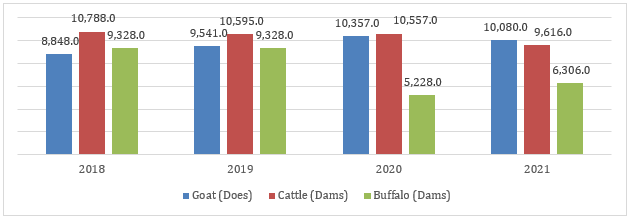
The National Dairy Authority (NDA) is the primary agency of the Philippine Department of Agriculture (DA) responsible for overseeing and supporting the development of the Philippines dairy market. The NDA aims to accelerate dairy herd development and milk production, expand the reach of school feeding programs, promote milk consumption, and foster the growth of the dairy industry through the provision of technical services.
The locally produced fresh milk classified as ready-to-drink milk (RTD) has inherent competitive advantages against the imported RTD in the fresh milk market. The market for RTD grows as a result of RA 11037 and RA 11148, requiring investment in the Milk Feeding Program (MFP) among preschoolers and malnourished school children. The Department of Education (DepEd) prioritises local dairy products in the school feeding program. Around 60% of the local fresh milk production goes to this program and the rest to local commercial sales or household consumption.
Figure: Milk Supplied by FCAs to Beneficiaries (Millions) under the DepEd School-based Feeding Program (SBFP), SY* 2019-2024

The Philippines’ self-sufficiency of milk is very low compared (less than 5%) to its demand for dairy products, which leads the country to import most of its requirements. Major suppliers of dairy products in the Philippines dairy market are Nestlé Philippines, Alaska Milk Corporation, and Fonterra Brands Philippines.
In 2024, production will rise to 29,000 MT, supported by an increase in the dairy herd and the active implementation of the government’s dairy development projects. As per 2023 report, Cow’s milk production represents around 60% share of total milk production in the Philippines.
Figure: Milk Production in Thousand MT (LME) in the Philippines, 2019-2024 (E)

The dining out trend in countries such as China, Japan, and India expand the foodservice sector, aiding the demand for dairy products. In 2022, China was the largest market globally for food and beverages, with a value of USD 178.3 billion. India is the largest milk producer globally. According to the FAO, in FY 2022-23, India’s milk production reached about 230.58 million tonnes from 187.30 million in 2018-19. According to 2024 data, India’s dairy sector boasts 22 Milk Federations/Apex Bodies, 240 district cooperative milk unions, 28 marketing dairies, and 24 milk producer organizations.
As per the Philippines dairy market report, the popularity of ice cream with distinct flavours such as pandan, green tea, lychee, and plum wine, are gaining momentum in Asia. China is a leading ice cream producer. According to 2024 data, there are 7,205 ice cream shops in China. Cheese is a key product in Australia's dairy sector, using over a third of the country's milk. In 2024, cheese production is projected to reach 435,000 tons, driven by higher milk supplies and strong profitability. Some leading cheese producers in Australia include L’artisan cheese, Milawa Cheese Company, and Woodside Cheese.
Rising health awareness, significant government support, and growing food service sector drive Philippines dairy market growth.
The growth of the food service sector has resulted in higher consumption of pizzas, burgers, coffee, and tea. This is driving the demand for dairy products such as cheese, ice cream, and milk. As per 2024 data, Philippines is the second-largest coffee consumer in Asia, with 80% of Filipinos drinking an average of 2.5 cups per day. The rising urbanisation and increasing income of population are catering to the growth of the food service sector in the Philippines, thereby supporting the Philippines dairy market value. According to December 2024 report, the Philippines has 49,629 restaurants, representing an increase of 4.43% from 2023. In the Calabarzon region, the coffee shop market represents the largest demand for fresh milk. To meet the growing needs of this market, milk from areas such as Bulacan, Nueva Ecija, Bukidnon, and other parts of Mindanao is also sourced and supplied by processors and traders in Batangas. The increasing number of coffee shops in Metro Manila and other urban areas drives this rising demand for fresh milk.
This roadmap outlines strategies, policies, budgetary requirements, implementation plans, and post-implementation programs, applicable to a range of industry stakeholders, from smallholder farms to large-scale dairy producers. As outlined in the Roadmap, the Philippines is projected to increase its cattle herd by 4,000 annually from 2021 to 2025, following an addition of 300 cattle in 2020, bringing the total to 20,300 cattle.
As per the Philippines dairy market analysis, dairy farmers in the Philippines are enhancing productivity by deploying advanced technologies. These technologies include embryo transfer and sexed semen with slick genes. Further, by artificially inseminating local cattle with 100% purebred Holstein-Friesian semen, farmers are upgrading local herds and increasing dairy animal numbers.
The majority of the Philippines' drinking milk market, including powdered milk, is primarily distributed through offline retail channels such as grocery stores. However, online marketplaces like Shopee and Lazada are also gaining popularity among consumers due to their wide product selection and reputation for offering special deals and promotions. Additionally, technological innovations such as smart carts, which automatically scan items as customers place them in their shopping carts, and self-service smart lockers, which allow for convenient pickup or drop-off of delivery items, are further driving the growth of the sector.
The rising incomes and growing middle class population in Philippines is fueling growth in spending for household goods and dairy products such as milk, cheese and yoghurt. The Philippines aims to become a predominantly middle-class society, free of poverty, by 2040. It is estimated that, the household goods spending in the Philippines will witness a CAGR of 7.1% from 2024-2028, significantly supporting the Philippines dairy market development.
The Philippines, located in Southeast Asia, is gaining recognition in the global dairy industry. As per 2024 statistics, the Philippines has the presence of approximately 615,000 dairy cattle. There is a growing demand for dairy products including milk and cheese among the population with the rise in health consciousness. The national recommendation for milk consumption in the Philippines suggests that children aged one to six years should consume at least one glass of milk or a milk-based product per day.
The Philippines is witnessing a strong inclination towards vegan and plant-based protein sources, such as soy. Non-dairy cheese alternatives suitable for vegans are expected to gain popularity in the Philippines. Currently considered a niche product, plant-based cheese has significant potential to become more mainstream in the coming years. Dairy-free ice cream is gaining traction amidst new product development and innovations. This includes the introduction of new flavours and formats, as well as products tailored to meet the needs of consumers with specific dietary requirements, such as those seeking dairy-free options.
As per 2021 data, the majority of the dairy farmers in the Cagayan Valley belonged to the aged group, with an average age of 54 and above. Additionally, as per 2023 records, the average age of Filipino farmers ranges from 55 years old to 59 years old, which would create a critical shortage of farmers in the upcoming 10 to 12 years, and hamper the Philippines dairy market growth.
“Philippines Dairy Market Report and Forecast 2026-2035” offers a detailed analysis of the market based on the following segments:
On the basis of product, the market can be divided into the following:
| CAGR 2026-2035 - Market by | Product |
| Whey Protein (Powder and Concentrate) | 7.8% |
| Yoghurt | 7.3% |
| Fluid/UHT/Flavoured Milk | XX% |
| Skimmed Milk Powder/Non-Fat Dry Milk | XX% |
| Cheese | XX% |
| Others | XX% |
By Product Analysis
The expanding Milk Feeding Program and the food service sector aids the demand for liquid RTD milk. Further, the demand for imported ultra-heat treated (UHT) milk is increasing due to its distinctive taste and longer shelf life, boosting the Philippines dairy market. Philippines imports UHT milk from countries including New Zealand, the USA, and Australia. According to USDA 2024 data, the Philippines average milk production is 10 liters/day for dairy cows, 4.5 litres/day for buffalo, and 1.5 litres/day for goats. In June 2023, the NDA announced its plans to boost local milk production by 500%, equivalent to 800 million liters within five years.
Fresh cream contains a significant amount of Vitamin B2, calcium and phosphorus, increasing its adoption among health-conscious individuals. While light creams are used in desserts and coffee, the heavier creams are whipped or used to thicken sauces. As per Philippines dairy market analysis, in 2022, the Philippines baking industry spent around USD 1.5 billion on ingredients, with 77% imported.
Butter is a staple pantry item in Filipino households, frequently used in both home cooking and baking. In December 2024, Japan’s Butter Butler, officially opened its first store in the Philippines. The company is renowned for its butter-centric pastries that are expected to gain the attention of Filipino dessert enthusiasts and expand the demand for butter.
Anhydrous Milk Fat (AMF) is made from 35-45% butter or cream. AMF is a good source of essential nutrients including vitamins A, D, E, and K, contains conjugated linoleic acid (CLA), promotes weight loss, boosts brain function, and supports heart health. AMF is a crucial for the food industry due to its longer shelf life. In 2022, limited-service restaurants held a 55% share of the consumer food service sector, followed by full-service restaurants (17%), street stalls/kiosks (15%), and cafés and bars (13%), thus boosting the Philippines dairy market.
Skimmed milk powder has the same nutritional content as liquid milk. Its lightweight nature and easy storage make it a convenient choice for travel and for situations where fresh milk is unavailable. The USA and New Zealand are the major suppliers of SMP to the Philippines. Due to its longer shelf life, skimmed milk powder is widely adopted in the commercial food and beverages sector. According to 2023 data, the Philippine’s food and beverage sector contributes around 23-24% of the country’s GDP.
Whole milk powder is produced by spray-drying pasteurised milk and contains 26%-40% milk fat (by weight). It retains the full nutritional value of milk in a dry form. Whole milk powder plays an important role in the manufacture of a wide range of food and reconstituted dairy products such as yoghurt and milk drinks.
The increasing awareness on the importance of protein in weight management and overall wellness drive the demand for whey protein. In 2022, whey protein imports increased to USD 111 million. The incorporation of protein-rich ingredients in product formulations among food manufacturers has increased the demand for whey protein. The development of innovative products such as flavoured, fortified and low-lactose whey proteins, further aids the Philippines dairy market growth.
The amount of lactose in dairy foods varies between products, ranging from 15g in a cup of milk to virtually zero in hard or mature cheeses. Lactose monohydrate is used as a sweetener or stabiliser in packaged foods, baked goods, and infant formulas. In 2022, the Philippines held a 0.6% market share in the global packaged food market, with a total value of USD 16.5 billion.
Cow's milk consists of around 80% casein protein. Generally, 1 ounce of cheddar or mozzarella cheese has more than 5 grams of casein. In addition to milk and cheese, casein protein is found in yogurt, and infant formulas, as well as in a variety of bakery products. According to USDA, by 2027, the Philippines baking industry’s retail sales are expected to grow 5% a year, reaching a total value of USD 2.5 billion, while also supporting the Philippines dairy market.
The government-owned Dairy Training and Research Institute (DTRI) and Philippine Carabao Center (PCC) produce white cheese from locally produced milk. Philippines is witnessing the expansion of fast-food, and pizza chains, contributing to the demand for cheese, thus increasing the Philippines dairy market share.
A standard serving of plain yogurt made from whole milk (245 grams) contains approximately 8.5 grams of protein. Yoghurt’s natural protein content and live bacteria culture make it a natural choice for health-conscious consumers. The prevalence of diabetes is expected to increase the demand for healthier low-sugar varieties with fewer additives. By 2045, 7.5 million individuals aged 20-79 years are projected to be diagnosed with diabetes compared to 4.3 million in 2021.
Fast food chains are expanding and are importing ice creams to meet their customer’s needs. Key importers of ice creams include McDonald’s and Jollibee Foods Corporation. Key ice cream brands in the Philippines dairy market include The Unilever Group (Selecta, Cornetto, Magnum) and Nestlé S.A. (Nestlé, Drumstick, Lait, Pinipig).
Leading dairy corporations consistently allocate resources towards research & development in order to provide inventive dairy products that satisfy changing consumer tastes. In order to satisfy the demands of health-conscious consumers, businesses also concentrate on creating value-added dairy products with practical advantages, like probiotic-enriched yogurt or fortified milk.
Nestlé Philippines, Inc., is a private subsidiary of Nestlé S.A. The company is a prominent producer and distributor of food and beverage products, recognized globally for its renowned brands. Founded in 1911, Its diverse product range includes baby foods, breakfast cereals, coffee, tea, dairy items, and frozen foods.
Alaska Milk Corporation, a subsidiary of Royal FrieslandCampina BV, is a leading dairy company in the Philippines committed to providing high-quality and affordable nutrition for families and children. Founded in 1972, Alaska Milk also actively supports corporate social responsibility initiatives, including milk feeding programs in schools and communities, sports development projects, and assistance for small businesses.
Yakult Philippines Incorporated, a subsidiary of Yakult Honsha, Co. Ltd., is committed to promoting health through its flagship probiotic drink, Yakult, featuring Lacticaseibacillus paracasei strain Shirota (LcS). Founded in 1978, the company has two manufacturing facilities in province of Laguna and El Salvador along with four depots which are strategically located in Marilao Bula iscan, Victoria Laguna, Antipolo City Rizal and Dasmariñas Cavite.
San Miguel Food and Beverage, Inc., is a leading Philippines company and sells its products under three different brand names: San Miguel Foods, San Miguel Brewery and Ginebra San Miguel Inc.. Founded in 1890, the company’s operations encompass the entire value chain, including animal feeds, fresh and processed meats, ready-to-eat meals, flour, dairy, spreads, and coffee.
*Please note that this is only a partial list; the complete list of key players is available in the full report. Additionally, the list of key players can be customized to better suit your needs.*
Other key players in the Philippines dairy market are Century Pacific Food Incorporated, Fonterra Brands Philippines, Inc., and Arla Foods Corp. Philippines, among others.




*While we strive to always give you current and accurate information, the numbers depicted on the website are indicative and may differ from the actual numbers in the main report. At Expert Market Research, we aim to bring you the latest insights and trends in the market. Using our analyses and forecasts, stakeholders can understand the market dynamics, navigate challenges, and capitalize on opportunities to make data-driven strategic decisions.*
Get in touch with us for a customized solution tailored to your unique requirements and save upto 35%!
In 2025, the market reached an approximate value of USD 1507.76 Million.
The dairy market is assessed to grow at a CAGR of 4.30% between 2026 and 2035.
The Philippines dairy market is estimated to witness healthy growth in the forecast period of 2026-2035 to reach a value of around USD 2297.08 Million by 2035.
The major market drivers include increasing health awareness among the regional population and growing availability of dairy products across online grocery shopping and e-commerce platforms.
The key trends fuelling the growth of the market include adoption of advanced technologies in dairy processing and rising investments by the key players of the market towards research and development activities.
The major types of dairy farms include commercial farms, individual smallholder producers, government farms, and smallholder cooperatives.
The market is broken down into Fluid/UHT/Flavoured Milk, Cream, Butter, Anhydrous Milk Fat (AMF), Skimmed Milk Powder/Non-Fat Dry Milk, Whole Milk Powder, Whey Protein (Powder and Concentrate), Lactose, Casein, Cheese, Yoghurt, Ice-Cream, and Probiotic Dairy Products.
The competitive landscape consists of Nestlé Philippines, Alaska Milk Corporation, Yakult Philippines Incorporated, San Miguel Food and Beverage, Inc., Century Pacific Food Incorporated, Mondelez International, and Fonterra Co-operative Group Limited among others.
Explore our key highlights of the report and gain a concise overview of key findings, trends, and actionable insights that will empower your strategic decisions.
| REPORT FEATURES | DETAILS |
| Base Year | 2025 |
| Historical Period | 2019-2025 |
| Forecast Period | 2026-2035 |
| Scope of the Report |
Historical and Forecast Trends, Industry Drivers and Constraints, Historical and Forecast Market Analysis by Segment:
|
| Breakup by Product |
|
| Market Dynamics |
|
| Competitive Landscape |
|
| Companies Covered |
|
Datasheet
One User
USD 2,499
USD 2,249
tax inclusive*
Single User License
One User
USD 3,999
USD 3,599
tax inclusive*
Five User License
Five User
USD 4,999
USD 4,249
tax inclusive*
Corporate License
Unlimited Users
USD 5,999
USD 5,099
tax inclusive*
*Please note that the prices mentioned below are starting prices for each bundle type. Kindly contact our team for further details.*
Flash Bundle
Small Business Bundle
Growth Bundle
Enterprise Bundle
*Please note that the prices mentioned below are starting prices for each bundle type. Kindly contact our team for further details.*
Flash Bundle
Number of Reports: 3
20%
tax inclusive*
Small Business Bundle
Number of Reports: 5
25%
tax inclusive*
Growth Bundle
Number of Reports: 8
30%
tax inclusive*
Enterprise Bundle
Number of Reports: 10
35%
tax inclusive*
How To Order

Select License Type
Choose the right license for your needs and access rights.

Click on ‘Buy Now’
Add the report to your cart with one click and proceed to register.

Select Mode of Payment
Choose a payment option for a secure checkout. You will be redirected accordingly.
Gain insights to stay ahead and seize opportunities.
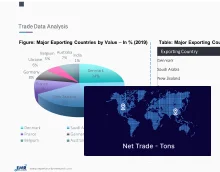
Get insights & trends for a competitive edge.
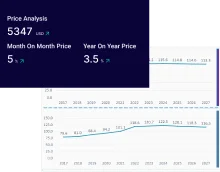
Track prices with detailed trend reports.
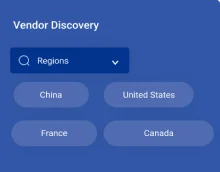
Analyse trade data for supply chain insights.

Leverage cost reports for smart savings
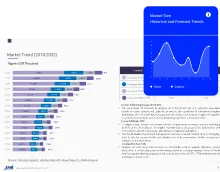
Enhance supply chain with partnerships.
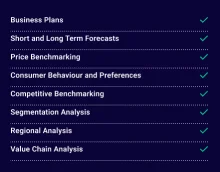
Connect For More Information
Our expert team of analysts will offer full support and resolve any queries regarding the report, before and after the purchase.
Our expert team of analysts will offer full support and resolve any queries regarding the report, before and after the purchase.
We employ meticulous research methods, blending advanced analytics and expert insights to deliver accurate, actionable industry intelligence, staying ahead of competitors.
Our skilled analysts offer unparalleled competitive advantage with detailed insights on current and emerging markets, ensuring your strategic edge.
We offer an in-depth yet simplified presentation of industry insights and analysis to meet your specific requirements effectively.
Share